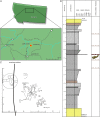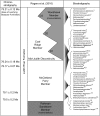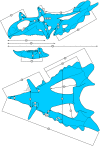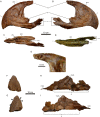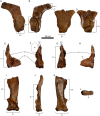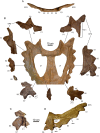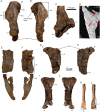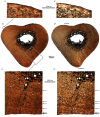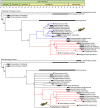Spiclypeus shipporum gen. et sp. nov., a Boldly Audacious New Chasmosaurine Ceratopsid (Dinosauria: Ornithischia) from the Judith River Formation (Upper Cretaceous: Campanian) of Montana, USA - PubMed (original) (raw)
Spiclypeus shipporum gen. et sp. nov., a Boldly Audacious New Chasmosaurine Ceratopsid (Dinosauria: Ornithischia) from the Judith River Formation (Upper Cretaceous: Campanian) of Montana, USA
Jordan C Mallon et al. PLoS One. 2016.
Abstract
This study reports on a new ceratopsid, Spiclypeus shipporum gen et sp. nov., from the lower Coal Ridge Member of the Judith River Formation in Montana, USA, which dates to ~76 Ma (upper Campanian). The species is distinguished by rugose dorsal contacts on the premaxillae for the nasals, laterally projecting postorbital horncores, fully fused and anteriorly curled P1 and P2 epiparietals, and a posterodorsally projecting P3 epiparietal. The holotype specimen is also notable for its pathological left squamosal and humerus, which show varied signs of osteomyelitis and osteoarthritis. Although the postorbital horncores of Spiclypeus closely resemble those of the contemporaneous 'Ceratops', the horncores of both genera are nevertheless indistinguishable from those of some other horned dinosaurs, including Albertaceratops and Kosmoceratops; 'Ceratops' is therefore maintained as a nomen dubium. Cladistic analysis recovers Spiclypeus as the sister taxon to the clade Vagaceratops + Kosmoceratops, and appears transitional in the morphology of its epiparietals. The discovery of Spiclypeus adds to the poorly known dinosaur fauna of the Judith River Formation, and suggests faunal turnover within the formation.
Conflict of interest statement
Competing Interests: The authors have declared that no competing interests exist.
Figures
Fig 1. Locality data for the holotype of Spiclypeus shipporum gen et sp. nov. (CMN 57081).
(A) Location of quarry within Montana, marked by star (map source: Google Earth); (B) stratigraphic section of holotype locality; (C) quarry map (by J. Small). Circled elements in (C) were exposed at the surface upon discovery. Curved lines in (C) represent ribs. Each grid square = 1 m2.
Fig 2. Idealized dinosaur biostratigraphy of the Judith River Formation.
Dates and stratigraphic nomenclature from Rogers et al. [10]. Faunal data from: 1, Sahni [12]; 2, Rogers and Brady [13]; 3, Marsh [3]; 4, Cope [14]; 5, Cope [15]; 6, Penkalski and Dodson [16]; 7, Ryan et al. [8]; 8, this study; 9, Leidy [17]; 10, Cope [18]; 11, Fiorillo and Currie [19]; 12, Fiorillo [20]; 13, Dodson [4]; 14, Freedman et al. [21]; 15, Schott et al. [22]; 16, Ryan [5]; 17, Ryan et al. [7]; 18, Longrich [6]. All taxa from terrestrial McClelland Ferry or Coal Ridge members. Asterisk (*) denotes holotype of key species. Abbreviations: D1-3, disconformities bounding depositional sequences of Woodhawk Member.
Fig 3. Skull reconstruction of Spiclypeus shipporum gen et sp. nov. (CMN 57081).
(A) Left lateral view; (B) right lateral view; (C) anterior view; (D) dorsal view. Missing parts of skull shown faded.
Fig 4. Skull measurements for Spiclypeus shipporum gen et sp. nov. (CMN 57081).
See Table 1 for corresponding measurement descriptions and values.
Fig 5. Snout elements of Spiclypeus shipporum gen et sp. nov. (CMN 57081).
Rostral bone and premaxillae in left lateral (A), right lateral (B), ventral (C), and dorsal (D) views; (E) dorsal nasal contact of premaxilla in right lateral view, outlined by white dashed line; nasal horncore in lateral views (F and G, precise orientation difficult to discern); left maxilla in lateral (H) and medial (I) views. Arrow heads indicate resorption pits on nasal horncore.
Fig 6. Postorbital horncores of Spiclypeus shipporum gen et sp. nov. (CMN 57081) and other chasmosaurines.
Right postorbital horncore of S. shipporum (CMN 57081) in ventrolateral (A), dorsomedial (B), and ventral (C) views; left postorbital horncore of S. shipporum (CMN 57081) in ventrolateral (D), dorsomedial (E), and ventral (F) views; left postorbital horncore of ‘_Ceratops montanus_’ (USNM 2411) in ventrolateral view (G); left postorbital horncore of Kosmoceratops (UMNH VP 17000; courtesy of UMNH) in ventrolateral view (H); right postorbital horncore of Albertaceratops (TMP 2002.003.0036) in ventrolateral view (I).
Fig 7. Infratemporal elements of Spiclypeus shipporum gen et sp. nov. (CMN 57081).
Left jugal in lateral (A) and medial (B) views; right jugal in lateral (C) and medial (D) views; left quadratojugal and epijugal in anterior (E), lateral (F), medial (G), and posterior (H) views; left quadrate in anterior (I), lateral (J), posterior (K), and ventral (L) views.
Fig 8. Parietosquamosal frill of Spiclypeus shipporum gen et sp. nov. (CMN 57081).
(A) Posterior parietal bar in posterior view; (B) reconstructed frill and related fossil material; (C) portion of anterior right squamosal in medial view; (D) reconstructed left squamosal showing fenestrae and associated abscess cavities.
Fig 9. Lower jaw elements of Spiclypeus shipporum gen et sp. nov. (CMN 57081).
Right dentary in lateral (A), medial (B), and dorsal (C) views; left dentary in lateral (D) and medial (E) views; right splenial in medial (F) and lateral (G) views.
Fig 10. Teeth of Spiclypeus shipporum gen et sp. nov. (CMN 57081).
(A) Left maxillary teeth in lateral view; (B) right dentary teeth in lateral view. (C) microwear on the 23rd right dentary tooth showing common dorsodistally-ventromesially oriented scratches; (D) microwear on the 13th right dentary tooth showing less common dorsomesially-ventrodistally oriented scratches.
Fig 11. Vertebrae of Spiclypeus shipporum gen et sp. nov. (CMN 57081) in anterior view.
Vertebrae A–H are dorsals of indeterminate position.
Fig 12. Appendicular elements of Spiclypeus shipporum gen et sp. nov. (CMN 57081).
Left humerus in dorsal (A) and ventral (B) views; (C) detail of osteomyelitic infection at distal end of humerus; (D) CT image of distal left humerus showing bony sequestra (indicated by red arrows); left ilium in dorsal (E) and ventral (F) views; left femur in anterior (G) and posterior (H) views; left tibia in anterior (I) and posterior (J) views; left fibula in anterior (K) and posterior (L) views.
Fig 13. Osteohistology of the fibula in Spiclypeus shipporum gen et sp. nov. (CMN 57081) in transverse section under normal (left) and polarized (right, prime designations) light.
(A) Close-up of inset in (B) showing the periosteal surface on the anterior side of the bone and the development of poorly vascularized, highly organized primary bone tissue of the external fundamental system; (B) full transverse section of fibula; and (C) close-up of inset in (B) exhibiting the least amount of remodelling and showing growth marks (indicated by arrows) in the primary bone tissue.
Fig 14. Cladograms showing evolutionary relationships within Chasmosaurinae.
Top: reduced strict consensus tree assuming traditional homology scheme for epiparietals (tree length = 332 steps, consistency index = 0.5873, retention index = 0.7345); Bottom: reduced strict consensus tree assuming new homology scheme for epiparietals (tree length = 439 steps, consistency index = 0.4487, retention index = 0.5346). Blue branches indicate ‘Chasmosaurus clade’ described in text; red branches indicate ‘Triceratops clade’. Numbers above nodes indicate bootstrap values >50%; numbers beneath nodes indicate Bremer support values >1.
Fig 15. Interpretation of CMN 9813 (paratype of ‘Pentaceratops aquilonius’) in Longrich [72] (left) and the present study (right).
In the right image, the specimen is mirrored about the midline to facilitate comparison. Note the differences in assumed epiossification homology. [Planned for column width].
Similar articles
- Lokiceratops rangiformis gen. et sp. nov. (Ceratopsidae: Centrosaurinae) from the Campanian Judith River Formation of Montana reveals rapid regional radiations and extreme endemism within centrosaurine dinosaurs.
Loewen MA, Sertich JJW, Sampson S, O'Connor JK, Carpenter S, Sisson B, Øhlenschlæger A, Farke AA, Makovicky PJ, Longrich N, Evans DC. Loewen MA, et al. PeerJ. 2024 Jun 20;12:e17224. doi: 10.7717/peerj.17224. eCollection 2024. PeerJ. 2024. PMID: 38912046 Free PMC article. - A New Brachylophosaurin Hadrosaur (Dinosauria: Ornithischia) with an Intermediate Nasal Crest from the Campanian Judith River Formation of Northcentral Montana.
Freedman Fowler EA, Horner JR. Freedman Fowler EA, et al. PLoS One. 2015 Nov 11;10(11):e0141304. doi: 10.1371/journal.pone.0141304. eCollection 2015. PLoS One. 2015. PMID: 26560175 Free PMC article. - A New Centrosaurine Ceratopsid, Machairoceratops cronusi gen et sp. nov., from the Upper Sand Member of the Wahweap Formation (Middle Campanian), Southern Utah.
Lund EK, O'Connor PM, Loewen MA, Jinnah ZA. Lund EK, et al. PLoS One. 2016 May 18;11(5):e0154403. doi: 10.1371/journal.pone.0154403. eCollection 2016. PLoS One. 2016. PMID: 27192148 Free PMC article. - A Re-Evaluation of the Chasmosaurine Ceratopsid Genus Chasmosaurus (Dinosauria: Ornithischia) from the Upper Cretaceous (Campanian) Dinosaur Park Formation of Western Canada.
Campbell JA, Ryan MJ, Holmes RB, Schröder-Adams CJ. Campbell JA, et al. PLoS One. 2016 Jan 4;11(1):e0145805. doi: 10.1371/journal.pone.0145805. eCollection 2016. PLoS One. 2016. PMID: 26726769 Free PMC article. - The origin and early evolution of dinosaurs.
Langer MC, Ezcurra MD, Bittencourt JS, Novas FE. Langer MC, et al. Biol Rev Camb Philos Soc. 2010 Feb;85(1):55-110. doi: 10.1111/j.1469-185X.2009.00094.x. Epub 2009 Nov 6. Biol Rev Camb Philos Soc. 2010. PMID: 19895605 Review.
Cited by
- Lokiceratops rangiformis gen. et sp. nov. (Ceratopsidae: Centrosaurinae) from the Campanian Judith River Formation of Montana reveals rapid regional radiations and extreme endemism within centrosaurine dinosaurs.
Loewen MA, Sertich JJW, Sampson S, O'Connor JK, Carpenter S, Sisson B, Øhlenschlæger A, Farke AA, Makovicky PJ, Longrich N, Evans DC. Loewen MA, et al. PeerJ. 2024 Jun 20;12:e17224. doi: 10.7717/peerj.17224. eCollection 2024. PeerJ. 2024. PMID: 38912046 Free PMC article. - The phylogenetic nomenclature of ornithischian dinosaurs.
Madzia D, Arbour VM, Boyd CA, Farke AA, Cruzado-Caballero P, Evans DC. Madzia D, et al. PeerJ. 2021 Dec 9;9:e12362. doi: 10.7717/peerj.12362. eCollection 2021. PeerJ. 2021. PMID: 34966571 Free PMC article. - Strong support for a heterogeneous speciation decline model in Dinosauria: a response to claims made by Bonsor et al. (2020).
Sakamoto M, Benton MJ, Venditti C. Sakamoto M, et al. R Soc Open Sci. 2021 Aug 25;8(8):202143. doi: 10.1098/rsos.202143. eCollection 2021 Aug. R Soc Open Sci. 2021. PMID: 34457325 Free PMC article. - Deep-time biodiversity patterns and the dinosaurian fossil record of the Late Cretaceous Western Interior, North America.
Maidment SCR, Dean CD, Mansergh RI, Butler RJ. Maidment SCR, et al. Proc Biol Sci. 2021 Jun 30;288(1953):20210692. doi: 10.1098/rspb.2021.0692. Epub 2021 Jun 23. Proc Biol Sci. 2021. PMID: 34157868 Free PMC article.
References
- Dodson P, Forster CA, Sampson SD. Ceratopsidae In: Weishampel DB, Dodson P, Osmólska H, editors. The Dinosauria. 2nd ed Berkeley: University of California Press; 2004. pp. 494–513.
- Farlow JO, Dodson P. The behavioral significance of frill and horn morphology in ceratopsian dinosaurs. Evolution. 1975;2: 353–361. - PubMed
- Marsh OC. A new family of horned Dinosauria, from the Cretaceous. Am J Sci, series 3. 1888;36: 477–478.
- Dodson P. Avaceratops lammersi: a new ceratopsid from the Judith River Formation of Montana. Proc Acad Nat Sci Phila. 1986;138: 305–17.
- Ryan MJ. A new basal centrosaurine ceratopsid from the Oldman Formation, southeastern Alberta. J Paleontol. 2007;81: 376–396.
MeSH terms
Grants and funding
The authors have no support or funding to report.
LinkOut - more resources
Full Text Sources
Other Literature Sources
